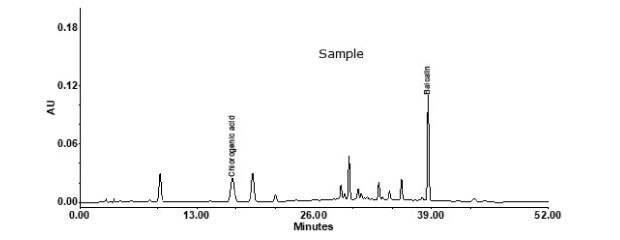Determination of Chlorogenic acid and Baicalin in Compounded Lonucerae Japonicae Flos using a Discovery® HS C18 Column
Dean DuanChinese Pharmacopeia method, MilliporeSigma, China application lab, Shanghai, China
Compounded Lonucerae Japonicae Flos is a kind of Traditional Chinese medicine (TCM). It has the effects of heat-clearing and detoxicating, cooling blood and detumescence. In this application, one Chinese pharmacopeia 2020 monograph method was validated using a Discovery® HS C18 HPLC column. The samples were first ground, and the active ingredients chlorogenic acid and baicalin were extracted with an aqueous methanol solution. All samples were filtered through Millex® PTFE syringe filters prior to HPLC-UV analysis. The limit of detection (LOD) and the limit of quantitation (LOQ) were found to be 0.07 µg/mL and 0.021 µg/kg, respectively, for chlorogenic acid, while the limit of detection (LOD) and the limit of quantitation (LOQ) were 0.27 µg/mL and 0.82 µg/kg, respectively, for baicalin. The method can be used for determination of chlorogenic acid and baicalin in compounded Lonucerae Japonicae Flos.

Figure 1. Chemical structures of chlorogenic acid and baicalin
Determination of chlorogenic acid and baicalin in compounded Lonucerae Japonicae Flos
Chromatograms at 278 nm for chlorogenic acid

Figure 2. Chromatogram of chlorogenic acid and baicalin standard solution

Figure 3. Chromatogram of compounded Lonucerae Japonicae Flos

Figure 4. Chromatogram of solvent blank
Chromatograms at 326 nm for baicalin

Figure 5. Chromatogram of chlorogenic acid and baicalin standard solution

Figure 6. Chromatogram of compounded Lonucerae Japonicae Flos

Figure 7. Chromatogram of solvent blank
Specificity and repeatability – chlorogenic acid and baicalin
Calibration data – chlorogenic acid

Figure 8. Calibration curve of chlorogenic acid
Calibration data – baicalin

Figure 9. Calibration curve of baicalin
Conclusion
The Chinese pharmacopeia 2020 monograph method was validated using a Discovery® HS C18 HPLC column. The method can be used for determination of chlorogenic acid and baicalin in compounded Lonucerae Japonicae Flos.
To continue reading please sign in or create an account.
Don't Have An Account?